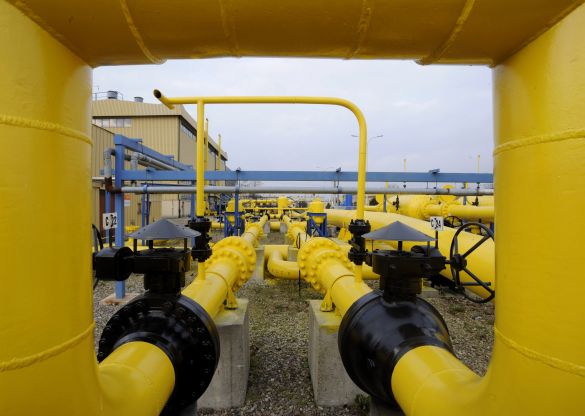
Russian-Polish Gas Agreement Leaves Key Questions Unanswered
Publication: Eurasia Daily Monitor Volume: 7 Issue: 198
By:

On October 29 in Warsaw, the Polish government and state gas company signed long-term supply and transit agreements with Russia, despite strong cautionary advice and warnings of legal action by the European Commission (EDM, October 4, 5). The agreements prolong and entrench Polish dependence on Gazprom as the single source of gas imports into the country.
The agreements include: additional protocols to the 1993 and 2003 inter-governmental agreements on gas transit and deliveries, as well as corporate agreements on Russian gas supplies to Poland. Those old agreements expired on October 20, 2010. Deputy Prime Minister, Waldemar Pawlak, the chief negotiator of the new agreements on the Polish side, signed the inter-governmental documents with his Russian counterpart, Igor Sechin; while Polish state gas company PGNIG’s President, Michal Szubski, and Gazprom’s Vice-President, Aleksandr Medvedev, signed the supply agreements. The information made available by both sides after the signing appears sketchy and opaque (Interfax, RIA Novosti, PAP, October 29).
The transit agreement prolongs Gazprom’s transit monopoly through the Polish section of the Yamal-Europe pipeline until 2019, with the option to negotiate a further prolongation until 2045. This pipeline, running across Poland to Germany, is jointly operated by Gazprom and PGNIG, making a post-2019 prolongation a high probability. By the same token this would strengthen Gazprom’s already dominant position in Germany for a long time to come. The line has a capacity of 33 billion cubic meters (bcm) per year, most of that volume being sold in Germany.
Under European energy market legislation, third-party gas suppliers –in this case, other than Gazprom– must be allowed through competitive bidding to use pipeline capacities. At the signing event, Aleksandr Medvedev remarked that the transit agreement “allows such access theoretically, but there are no free capacities in the pipeline.” This implies that Gazprom has preemptively contracted for using the full capacity of the pipeline on Polish territory (Interfax, October 29). If so, this provides another example of Russian energy companies’ denial-of-access tactics; in this case, with a willing Polish government. The “theoretical” provision about third-party access seems intended to fend off the European Commission, without satisfying EU anti-monopoly requirements.
The joint venture Europolgas owns and operates the Polish section of the Yamal-Europe pipeline. Gazprom and PGNIG hold stakes of 48 percent each in Europolgas, with their own joint venture Gas-Trading holding 4 percent. Under the agreements just signed, Poland’s national transmission operator Gas-System is taking over some of the operating functions on the transit pipeline. Gas-System’s actual powers, and the extent of its independence in the new arrangement, have yet to be disclosed. Initial reports suggest that Gas-System would act mainly as technical operator on the transit pipeline. Thus, Europolgas would decide what capacities, if any at all, may be available to third-party users. Moreover, the inter-governmental agreement has already established a formula for calculating transit fees for Gazprom’s gas (Bloomberg, October 29).
Under EU energy market legislation, however, the independent pipeline operator must have the authority to set transit fees as necessary for pipeline upkeep, as well as allocate pipeline capacities to gas suppliers. Current EU policy also requires the operator to equip the pipeline for two-directional use. In Poland’s case, this would allow gas supplies to reach Poland from the West, in the event of disruption of supplies from Russia.
The supply agreements just signed increase Russian gas deliveries from 9.7 bcm in 2010 to 10.5 bcm in 2011, and 11 bcm per year from 2012 until 2022. The sides retain the option to negotiate a further prolongation until 2037, depending on Polish demand. The October 29 agreement supersedes the earlier one whereby Poland was to have imported up to 8 bcm through 2014, and 9 bcm from 2015 onward.
Poland consumes some 14 bcm of gas annually (unaffected by the economic recession elsewhere). The country produces some 4.3 bcm per year internally while importing the remainder from Gazprom. The deliveries enter Poland through the Yamal-Europe pipeline, except some 2 bcm to 2.5 bcm per year that were being delivered by Gazprom’s offshoot RosUkrEnergo via Ukraine until 2009. In that year, however, Gazprom removed RosUkrEnergo from the business; and in 2010, the new Ukrainian government did not allow the transit of gas to Poland from third-party suppliers. Closure of the Ukrainian route generated pressure on Poland to negotiate with Gazprom for additional volumes via the Yamal-Europe pipeline.
These agreements seem designed to cover Poland’s import requirements during this decade. Thus, Polish interest in diversification of imports could diminish. This could discourage plans to build a liquefied natural gas (LNG) import terminal at Swinoujscie on the Baltic coast by 2014, or to increase domestic production. Such a result would be a foregone conclusion if the agreement just signed with Gazprom were on a take-or-pay basis. This is another key issue awaiting clarification.
The pricing arrangements remain confidential. According to Sechin, the Russian side could offer price discounts, if Poland decides to purchase additional gas volumes. Russian gas to be pumped through the Yamal-Europe pipeline can be, under these agreements, “of Russian and/or other provenance” (Interfax, RIA Novosti, October 29). This suggests that Russia intends to revert to the practice of absorbing and re-exporting Central Asian gas to Europe, if the EU and United States act indecisively in Turkmenistan.




